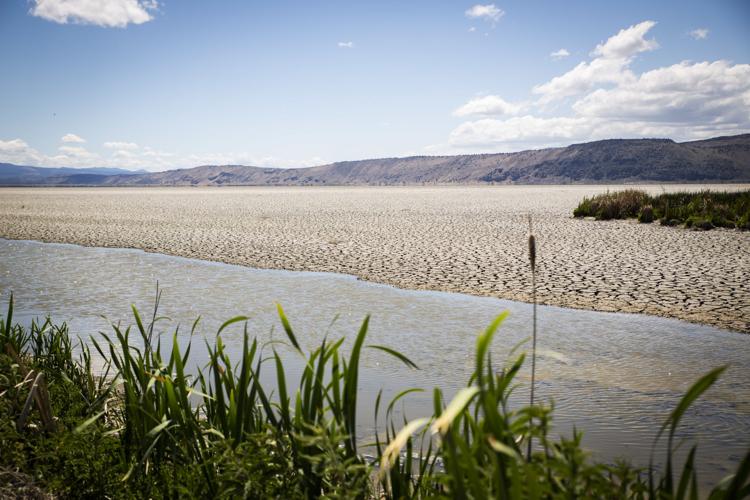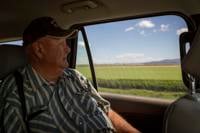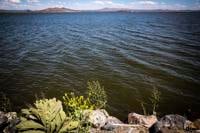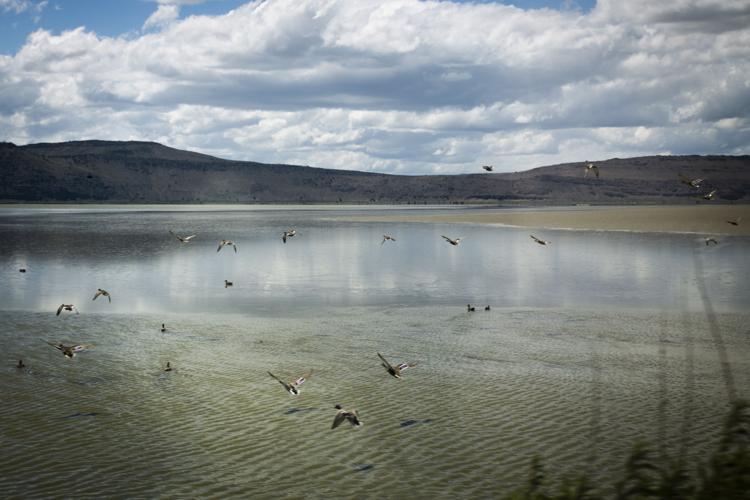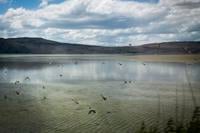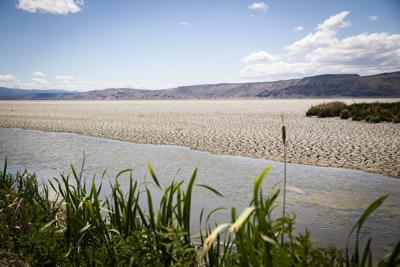T ULELAKE — Once spanning 100,000 acres at the foot of the Medicine Lake Volcano, it’s unlikely that Tule Lake has been as low as it is now for millions of years.
What used to be a massive network of open water and fringe wetlands is now essentially a giant mud puddle, spelling trouble for migratory birds that have used it as a rest stop for thousands of years.
×
Javascript is required for you to be able to read premium content. Please enable it in your browser settings.
kAm%96 D@=FE:@?[ 2E =62DE 7@C ?@Hn sCJ :E FA]k^Am
kAm%96 &]$] u:D9 2?5 (:=5=:76 $6CG:46[ H9:49 >2?286D E9 %F=6 {2<6 }2E:@?2= (:=5=:76 #67F86 2?5 %F=6=2<6 xCC:82E:@? s:DEC:4E[ 2C6 H@C<:?8 H:E9 H2E6C7@H= 4@?D6CG2E:@? @C82?:K2E:@? sF4<D &?=:>:E65 E@ >@G6 2D >F49 2D `a[___ 24C6\766E @7 H2E6C 36EH66? EH@ =2C86 H6E=2?5 F?:ED @? E96 C67F86] q:@=@8:DED 2?5 :CC:82E@CD 2=:<6 9@A6 E96 F?56CE2<:?8 H:== 8:G6 3:C5D 2 36EE6C 492?46 2E DFCG:G:?8 E9:D DF>>6C’D 9:DE@C:4 5C@F89E]k^Am
kAmp7E6C E96 qFC62F @7 #64=2>2E:@? 5C2:?65 >F49 @7 %F=6 {2<6 :? E96 62C=J a_E9 r6?EFCJ E@ >2<6 H2J 7@C z=2>2E9 !C@;64E 72C>=2?5[ E96 C67F86 H2D 6DD6?E:2==J 5:G:565 :?E@ 7@FC BF25C2?ED] $F>A `p[ :? E96 ?@CE9H6DE[ :D 2AAC@I:>2E6=J h[___ 24C6D @7 @A6? H2E6C 2?5 7C:?86 H6E=2?5D 2E E96 >@FE9 @7 {@DE #:G6C]k^Am
A map of the four sumps of Tule Lake National Wildlife Refuge.
Illustration by Alex Schwartz
kAm%96 D@FE9H6DE 2?5 ?@CE962DE DF>AD 2C6 3@E9 >256 FA @7 28C:4F=EFC2= =62D6=2?5D[ H96C6 72C>6CD @A6C2E6 :? 4@@A6C2E:@? H:E9 C67F86 8@2=D E@ AC@G:56 923:E2E 2?5 7@@5 7@C >:8C2E@CJ 3:C5D] $F>A `q[ :? E96 D@FE962DE[ 4@>AC:D6D 2 =:EE=6 @G6C b[___ 24C6D @7 A6C>2?6?E H6E=2?5D[ 4@??64E65 E@ $F>A `p E9C@F89 2 =2C86 42?2= <?@H? 2D E96 “t?8=:D9 r92??6=]”k^Am
kAmr=62C=J G:D:3=6 2=@?8 E96 C@25 E@ E96 ?@CE9 6?EC2?46 @7 {2G2 q65D }2E:@?2= |@?F>6?E[ $F>A `p :D H92E >@DE G:D:E@CD E@ E96 2C62 H@F=5 4@?D:56C “%F=6 {2<6]” u@C 564256D :E H2D >@DE=J @A6? H2E6C[ H:E9 2 76H >2CD9J 2C62D ?62C H96C6 E96 {@DE #:G6C 6?E6CD 7C@> E96 ?@CE9]k^Am
kAmqJ >:5\yF?6 :? a_a`[ 2=>@DE 2== E96 H2E6C H2D 8@?6 :? E92E 2C62[ 2?5 E96 =2C86 4C24<D 492C24E6C:DE:4 @7 D6G6C6 5C@F89E C2? E9C@F89 E96 5CJ =2<6365]k^Am
kAm“x? E96 =2DE E9@FD2?5 J62CD :E 92D ?6G6C =@@<65 =:<6 E92E[” D2:5 %F=6=2<6 72C>6C y@9? rC2H7@C5]k^Am
Waterfowl fly over Tule Lake Sump 1A. Sump 1A is being drained to try and prevent the spread of botulism. Eventually, it will be refilled to create a food supply and better environment for waterfowl.
H&N Staff Photo by Arden Barnes / Report for America
kAmkDEC@?8m‘s625 >2CD9’k^DEC@?8mk^Am
kAmy677 |4rC62CJ[ 5:C64E@C @7 @A6C2E:@?D 7@C sF4<D &?=:>:E65’D H6DE6C? C68:@?[ D2:5 H9:=6 E96 @A6? H2E6C @7 $F>A `p >2J 92G6 =@@<65 =:<6 2? 2G:2? A2C25:D6 3642FD6 @7 E96 D966C ?F>36C @7 3:C5D E96C6 :? A2DE J62CD[ :E 5:5 ?@E AC@G:56 E96> >F49 3J H2J @7 923:E2E @C ?FEC:E:@?]k^Am
kAm“(6 42== :E 2 5625 >2CD9] xE’D ?@E AC@5F4E:G6[” |4rC62CJ D2:5] “q:C5D ;FDE 8@ E96C6 E@ =2?5 2?5 C6DE]”k^Am
kAm$F>A `q[ 4@?G6CD6=J[ 925 364@>6 G6C:E23=6 H6E=2?5 t56? 27E6C 36:?8 5C2H? 5@H? =2DE J62C] u@@5 2?5 923:E2E 7@C 2 G2C:6EJ @7 3:C5 =:76 4J4=6 ?665D :D 8C@H:?8 :? 23F?52?46 E9:D DF>>6C]k^Am
kAmu:D9 2?5 (:=5=:76 92D 366? ECJ:?8 E@ 249:6G6 k2 9C67lQ9EEADi^^HHH]5F4<D]@C8^AC6DD\C@@>^?6HD\C6=62D6D^H9J\EF=6\=2<6\?HC\DF>A\`3\:D\8@:?8\5CJQ E2C86ElQ03=2?<QmD:>:=2C C6DF=EDk^2m 7@C $F>A `p[ H9:49 92D 366? <6AE 49C@?:42==J H6E 6G6? :? 5C@F89E J62CD]k^Am
kAmqFE E96 AC@;64E H@F=5 92G6 366? 4@DE=J[ 6DA64:2==J 4@?D:56C:?8 E96 724E E92E >@DE @7 E96 z=2>2E9 !C@;64E’D E2:=H2E6C 6?5D FA :? E96 DF>A 2?5 H@F=5 92G6 E@ 36 5:G6CE65]k^Am
kAm%9:D J62C[ E92E H2D E96 @?6 E9:?8 %xs 2?5 C67F86 >2?286CD 5:5?’E 92G6 E@ H@CCJ 23@FE[ 2D 566A 5C@F89E 2?5 t$p 4@?D:56C2E:@?D 4@>3:?65 E@ 4C62E6 4@?5:E:@?D ?646DD2CJ E@ 5C2H 5@H? E96 >2DD:G6 3@5J @7 H2E6C]k^Am
kAm“$F>A `p 92D ?6G6C 925 E92E =FIFCJ F?E:= E9:D J62C[” |4rC62CJ D2:5] “&?7@CEF?2E6=J[ :E’D E2<:?8 2 K6C@ 2==@42E:@? @FE @7 E96 !C@;64E E@ 86E E@ E9:D A@:?E]”k^Am
kAm%96 9@A6 :D E92E C6>@G:?8 E96 H2E6C 7C@> $F>A `p H:== 3C:?8 ?6H =:76 E@ E92E 4C24<65 62CE9] s6DA:E6 E96:C ?2>6[ |4rC62CJ D2:5 H6E=2?5D 24EF2==J ?665 D@>6 5CJ J62CD E@ C6>2:? 962=E9J] !=2?ED =:<6 D>2CEH665 2?5 8@@D67@@E[ D@>6 @7 5F4<D’ 72G@C:E6 7@@5D[ 5@?’E 86C>:?2E6 H96? E96J’C6 4@?D:DE6?E=J :?F?52E65 H:E9 D:=EJ H2E6C[ 2D E96J 92G6 366? :? $F>A `p]k^Am
kAmqC25 z:C3J[ >2?286C @7 %F=6=2<6 xCC:82E:@? s:DEC:4E[ D2:5 96 6IA64ED E96 32CC6? =2?5D42A6 E@ =@@< G6CJ 5:776C6?E :? 2 >@?E9 @C D@]k^Am
kAm“xE’== =@@< =:<6 2 >625@H[” 96 D2:5]k^Am
In this photo from June, Tule Lake Sump 1B had plenty of water after it was moved from across the refuge. By August the sump was dangerously low.
H&N Staff Photo by Arden Barnes / Report for America
kAmqFE E96 86C>:?2E:@? @7 H6E=2?5 A=2?ED :D @?=J 2 D64@?52CJ 8@2= @7 E96 5C2H5@H?[ H9:49 :D 36:?8 5@?6 >2:?=J E@ >:E:82E6 2 3@EF=:D> @FE3C62< 5FC:?8 H92E’D 6IA64E65 E@ 36 2 =@?8[ 9@E[ 5CJ DF>>6C]k^Am
kAm~? E96 D@FE9 6?5 @7 E96 DF>A[ 4@?5:E:@?D 2C6 2 =:EE=6 >@C6 4@?46C?:?8] %:?J 2>@F?ED @7 H2E6C DE:== C6>2:? 24C@DD 2 H:56 2C62[ 7@C>:?8 H92E’D 6DD6?E:2==J >F4< E92E @?=J 2 3:C5 4@F=5 DE2?5 :? H:E9@FE D:?<:?8] ~?46 E6>A6C2EFC6D :?4C62D6 =2E6C E9:D >@?E9[ 4@?5:E:@?D E96C6 H:== 36 C:A6 7@C 2 3@EF=:D> @FE3C62< :7 >@C6 H2E6C :D?’E C6>@G65]k^Am
kAmq@EF=:D> =:6D 5@C>2?E :? H6E=2?5 D@:=D 2?5 =2<6365D 3FE 2H2<6?D H96? H2E6C :D =@H 2?5 42=>[ 2?5 E6>A6C2EFC6D 2C6 9@E] q:C5D 4@?EC24E E96 324E6C:2 E9C@F89 >288@ED 2?5 364@>6 A2C2=JK65 E@ G2CJ:?8 568C66D] ~?46 E96J’C6 F?23=6 E@ >@G6 E96:C 9625D[ E96J’== 7=@A @G6C :? E96 D92==@H H2E6C 2?5 6G6?EF2==J 5C@H?] |@C6 >288@ED 7665 @? E96 42C42DD6D @7 3:C5D E92E 92G6 DF44F>365 E@ E96 5:D62D6[ DE2CE:?8 E96 4J4=6 2== @G6C 282:?]k^Am
kAm#67F86 >2?286CD 92G6 EH@ @AE:@?D E@ >:E:82E6 3@EF=:D> @FE3C62<Di v:G6 E96 2C62 2? :?7FD:@? @7 4@@=[ 4=62C H2E6C @C 5C2:? :E 4@>A=6E6=J E@ 5CJ @FE E96 324E6C:2’D 923:E2E] x? a_a`[ E96 7@C>6C H@F=5 36 2 =:E6C2= A:A6 5C62>]k^Am
kAm“(6’C6 ECJ:?8 E@ 6=:>:?2E6 2D >F49 @7 E9:D 2D H6 42?[” rC2H7@C5 D2:5] “&?7@CEF?2E6=J[ E96 3:C5D =@G6 E9:D] %96J =@G6 E@ 36 23=6 E@ DE2?5 :?DE625 @7 DH:>] p?5 E92E :D 2 C64:A6 7@C 3@EF=:D>]”k^Am
kAm{2DE J62C[ %F=6 {2<6 2?5 {@H6C z=2>2E9 }2E:@?2= (:=5=:76 #67F86D 6IA6C:6?465 @?6 @7 E96:C k2 9C67lQ9EEADi^^HHH]96C2=52?5?6HD]4@>^?6HD^=@42=0?6HD^H:=5=:76\C67F86D\32EE=6\56G2DE2E:?8\3@EF=:D>\@FE3C62<\H@CD6?65\3J\H2E6C\D9@CE286D^2CE:4=60hfbb`e_4\35bc\d5ce\2ecc\a`ah2ac7`hgh]9E>=Q E2C86ElQ03=2?<QmH@CDE 3@EF=:D> @FE3C62<D :? 9:DE@CJk^2m[ H9:49 <:==65 2E =62DE e_[___ 5F4<D 2?5 D6?E E9@FD2?5D @7 H2E6C7@H= E@ q:C5 p==J )’D 5F4< 9@DA:E2= :? pC42E2[ r2=:7][ H9:49 DECF88=65 E@ 92?5=6 E96 :?7=FI @7 A2E:6?ED H:E9 =:>:E65 7F?5:?8 2?5 DE277]k^Am
kAmx? 255:E:@? E@ 2DD:DE:?8 H:E9 E96 $F>A `p 5C2H5@H?[ |4rC62CJ D2:5 sF4<D &?=:>:E65 :D 2=D@ H@C<:?8 H:E9 u:D9 2?5 (:=5=:76 E@ AC@G:56 >@C6 7F?5:?8 E@ E96 5F4< 9@DA:E2= :? 25G2?46 @7 E9:D J62C’D 3@EF=:D> D62D@?] q:C5 p==J ) :D 2=D@ D66<:?8 k2 9C67lQ9EEADi^^8:G:?8E@@=D]4@>^8:G6^`ehQ E2C86ElQ03=2?<Qm5@?2E:@?Dk^2m 7@C E9:D J62C’D 3@EF=:D> C6DA@?D6]k^Am
kAmqFE 96 D2:5 E96 5C2H5@H? D9@F=5 8:G6 C67F86 >2?286CD 2 D6C:@FD 9625 DE2CE :? 4@>32EE:?8 @FE3C62<D E9:D DF>>6C]k^Am
kAm“%96 5C2:?286 :D 9F86] xE’D 23D@=FE6=J E96 36DE E9:?8 E92E 4@F=5 36 92AA6?:?8 7@C 4@?EC@==:?8 E96 3@EF=:D>[” 96 D2:5]k^Am
kAmx? |2J[ 27E6C E96 t?8=:D9 r92??6= 925 366? @A6?65 2?5 E96 EH@ DF>AD C624965 6BF:=:3C:F>[ %xs 3682? FD:?8 @?6 @7 :ED 6I:DE:?8 AF>AD E@ EC2?D76C >@C6 H2E6C 7C@> `p E@ `q] p3@FE `d_ r’H22> W{@DE #:G6C DF4<6CDX H6C6 2=D@ >@G65 7C@> $F>A `p E@ $F>A `q AC:@C E@ E96 5C2H5@H? E@ 4@>A=J H:E9 t?52?86C65 $A64:6D p4E C6BF:C6>6?ED]k^Am
kAmw2G:?8 366? 5C:65 @FE =2DE J62C[ `q’D =2<6365 H2D >@C6 4@>A24E65 2?5[ E96C67@C6[ 23=6 E@ 36 7:==65 566A6C E92? `p[ z:C3J D2:5] tG2A@C2E:@? H:==:?8[ 3:@=@8:DED 9@A6 E96 DF>A H:== C6>2:? 566A 6?@F89 E@ 2G@:5 E96 @?D6E @7 3@EF=:D> @FED:56 E96 D9@C6=:?6D[ H96C6 EC:286 4C6HD 42? >@C6 62D:=J 2446DD D:4< @C 5625 3:C5D 2?5 C6>@G6 E96> 7C@> E96 DJDE6>]k^Am
A map in the Tulelake Irrigation District office shows the breakout of what is being grown in each field in the district. Orange shows non-irrigated land.
H&N Staff Photo by Arden Barnes / Report for America
kAmkDEC@?8mr92==6?86D C6>2:?k^DEC@?8mk^Am
kAmz:C3J D2:5 :E H2D E@F89 E@ 7:8FC6 @FE 6I24E=J 9@H >F49 H2E6C 96 H2D H@C<:?8 H:E9 :? $F>A `p[ 8:G6? 9@H >F49 D:=E H2D :? :E] xE 8@E E@ 2 A@:?E H96C6 96 4@F=5?’E C62==J E6== H96C6 E96 H2E6C DE@AA65 2?5 E96 =2<6365 3682?] %96 @?=J E@@= 96 925 E@ 6DE:>2E6 E96 =2<6’D G@=F>6 H2D 2 `hge 2C62 42A24:EJ 4FCG6[ H9:49 =:<6=J 5:5?’E E2<6 :?E@ 244@F?E 9@H >F49 D:=E H@F=5 92G6 244F>F=2E65 :? E96 =2<6 @G6C D@ >2?J 564256D]k^Am
kAm“}@3@5J <?@HD H92E E96 3@EE@> @7 E9:D E9:?8 C62==J =@@<D =:<6[” z:C3J D2:5]k^Am
kAmw6 2?5 C67F86 3:@=@8:DED 92G6 D:?46 D6EE=65 @? 23@FE `a[___ 24C6\766E[ 2?5 E96C6’D 24EF2==J 2 4@?46C? E92E H:== ?@E 6G6? 36 6?@F89 H2E6C E@ 7:== $F>A `q]k^Am
kAm|4rC62CJ D2:5 u:D9 2?5 (:=5=:76 >2J FD6 2 “7=@2E:?8 6I42G2E@C” E@ 5:8 492??6=D :? E96 >F55J =2<6365 2?5 2==@H E96 E9:?[ AF55=65 H2E6C DE:== C6>2:?:?8 E@ 7=@H E@ E96 AF>A’D :?E2<6 2?5 @? E@ $F>A `q]k^Am
kAmxE EFC?D @FE E92E 6G6? 2>:5 @?6 @7 E96 z=2>2E9 q2D:?’D H@CDE 5C@F89ED :? C64@C565 9:DE@CJ[ :E’D AC@G:?8 5:77:4F=E E@ 86E E96 G6CJ =2DE 5C@AD @7 H2E6C @FE @7 $F>A `p]k^Am
kAm“(6’C6 5@H? E@ E96 A@:?E @7 H96C6 H6 92G6 E@ 86E 4C62E:G6[” z:C3J D2:5]k^Am
kAmrC2H7@C5 D2:5 D@>6 @7 $F>A `p DE:== 92D E96 23:=:EJ E@ 7:== 2 5:E49 56=:G6C:?8 H2E6C E@ E96 $@FE9H6DE $F>A[ 2==@H:?8 >@C6 3:C5 7@@5 E@ 36 8C@H? @? E9@D6 =62D6=2?5D] u2C>6CD E96C6 92G6 4@?EC24ED H:E9 E96 C67F86 E@ =62G6 369:?5 2 46CE2:? A6C46?E286 @7 8C2:? :? E96:C 7:6=5D 27E6C 92CG6DE 7@C E96 6IAC6DD AFCA@D6 @7 >:8C2E@CJ 3:C5 D?24<D]k^Am
Farmer John Crawford looks out over his field located in the Tule Lake National Wildlife Refuge. "This is my only field of grain," he said. With little water available to use, farmers had to make hard choices about how much of each crop they could plant.
H&N Staff Photo by Arden Barnes / Report for America
kAm$E:==[ E96 5:DEC:4E 2?5 E96 C67F86 2C6 :? 2 C246 282:?DE E:>6] %96:C 8@2= :D E@ 92G6 $F>A `p 2D 5CJ 2D A@DD:3=6 3J yF=J `[ H96? 3:@=@8:DED EJA:42==J 8@ @? 2=6CE 7@C 3@EF=:D> @FE3C62<D]k^Am
kAm“(6 DE:== 6IA64E E92E E96C6 H:== 36 D@>6 =6G6= @7 2 3@EF=:D> @FE3C62<[ 3FE E96 2>@F?E @7 D92==@H H2E6C H:== 36 =6DD[” |4rC62CJ D2:5]k^Am
kAmp?5 E96? E96C6’D E96 4@?46C? 7@C ?6IE J62C[ H96? $F>A `p H:== 92G6 E@ 36 C67:==65 27E6C E96 A=2?ED 86C>:?2E6] z:C3J D2:5 E92E F?=6DD 5:776C6?E >2?286>6?E 564:D:@?D 2C6 >256[ 96’== 36 92C5\AC6DD65 E@ AFE H2E6C 324< @? E96 =2<6365 2?5 4@>A=6E6 E96 AC@;64E’D =@?8\E6C> 8@2= @7 C6G:G:?8 $F>A `p’D H6E=2?5D]k^Am
kAm“x 5@?’E <?@H H96C6 E9:D H2E6C :D 8@:?8 E@ 4@>6 7C@> :7 H6 5@?’E 92G6 @?6 @7 E96 36DE H:?E6CD :? E96 A6C:@5 @7 C64@C5[” z:C3J D2:5]k^Am
kAmkDEC@?8mt4@DJDE6> D@=FE:@?Dk^DEC@?8mk^Am
kAm|4rC62CJ D2:5 E9:D <:?5 @7 AC@;64E :D A2CE @7 2 3C@256C H2J @7 E9:?<:?8 23@FE %F=6 {2<6 #67F86[ 2?5 E96 z=2>2E9 q2D:? 2D 2 H9@=6] x? E96 62C=J a___D[ C67F86 DE2<69@=56CD 56G6=@A65 2 A=2? 42==65 “DF>A C@E2E:@?[” H96C6 E96 7@FC BF25C2?ED H@F=5 C@E2E6 36EH66? H6E=2?5D 2?5 28C:4F=EFC2= =2?5D]k^Am
kAm“(96? H6 =@@< 2E E96 32D:? 2D 2 H9@=6[ H6 D66 E92E E96C6’D ?@E C62==J 2? 64@DJDE6> A6CDA64E:G6 23@FE 9@H E9:?8D 2C6 H@C<:?8 @FE E96C6[” 96 D2:5] “(96? H6 =@@< 2E 2? 64@DJDE6> D@=FE:@?[ :E :?4=F56D D2=>@?[ DF4<6CD[ 72C>6CD[ H2E6C7@H= 2?5 H6E=2?5D] (6 E9:?< E96C6’D 2 D@=FE:@? @FE E96C6 E92E 42? D2E:D7J 2== E96D6 :?E6C6DED]”k^Am
kAm%9:D AC@46DD :D 2=C625J 92AA6?:?8 :? E96 32D:? 2E 2 D>2==6C D42=6 E9C@F89 E96 (2=<:?8 (6E=2?5D AC@8C2>[ H96C6 72C>6CD 7=@@5 :CC:82E6 E96:C 7:6=5D 2?5 =62G6 E96> 2D H6E=2?5D — AC@G:5:?8 4C:E:42= 3:C5 923:E2E — 2?5 A=2?E @C82?:4 4C@AD 27E6C E96 H2E6C 92D 366? 5C2:?65] x?DE625 @7 2 D:?8=6 7:6=5 C@E2E:?8 :? 2?5 @FE @7 H6E=2?5 DE2EFD[ >2?286CD H@F=5 5@ E92E H:E9 6?E:C6 DF>AD @? E96 C67F86]k^Am
kAm“tDD6?E:2==J[ J@F’C6 5@:?8 (2=<:?8 (6E=2?5D @? 2 G6CJ =2C86 D42=6[” |4rC62CJ D2:5] “%92E >2:?E2:?D 2 AC6EEJ DEC@?8[ C@3FDE H6E=2?5 DJDE6> 5@H? E96C6]”k^Am
kAmqFE E96C6’D 2 =@E @7 :CC:82E:@? :?7C2DECF4EFC6 ?66565 E@ >2<6 DF>A C@E2E:@? 2 C62=:EJ[ =:<6 5C2:?286D 2?5 =2E6C2=D[ E92E 5@?’E 6I:DE @? $F>AD `p 2?5 `q] sF4<D &?=:>:E65 :D DE:== H@C<:?8 @? 2 762D:3:=:EJ DEF5J 7@C E96 4@?46AE]k^Am
kAmp>6=:2 #2BF6=[ 2 sF4<D &?=:>:E65 3:@=@8:DE H9@ 92D 366? 96=A:?8 %xs 2?5 u($ @? E96 8C@F?5[ E9:?<D E96 $F>A `p 5C2H5@H? :D D@>6H92E @7 2 “AC@@7 @7 4@?46AE” 7@C DF>A C@E2E:@?[ 2==@H:?8 DE2<69@=56CD E@ D66 H92E’D A@DD:3=6 F?56C 2 ?6H C67F86 H2E6C >2?286>6?E C68:>6]k^Am
kAm“xE’D D9@H? E92E E96C6 :D D@>6 A@DD:3:=:EJ H:E9 6I:DE:?8 :?7C2DECF4EFC6[” D96 D2:5] “~3G:@FD=J H6’C6 8@:?8 E@ ?665 255:E:@?2= :?7C2DECF4EFC6[ 3FE :E 2==@HD FD E@ D66 H92E E96 3@EE@> @7 `p =@@<D =:<6[ 9@H J@F 42? >@G6 H2E6C 2?5 H96C6 J@F 42? >@G6 :E]”k^Am
A sign in the Tulelake Irrigation District office reads "Whiskey is for drinking and water is for fighting over."
H&N Staff Photo by Arden Barnes / Report for America
kAmrC2H7@C5[ H9@’D 72C>65 :? E96 (2=<:?8 (6E=2?5D AC@8C2> 2?5 @? C67F86 =62D6=2?5D[ D2:5 96’D 2== 7@C EC62E:?8 E96 %F=6 {2<6 64@DJDE6> >@C6 9@=:DE:42==J] q6J@?5 4@?EC:3FE:?8 E@ D@>6 @7 E96 >@DE AC@5F4E:G6 3:C5 923:E2ED @? E96 !24:7:4 u=JH2J[ 72C>:?8 :? E2?56> H:E9 H6E=2?5 923:E2ED >62?D 96 H@F=5 86E E@ FD6 =6DD A6DE:4:56D 2?5 76CE:=:K6C 2?5 8C@H 4C@AD @? D@>6 @7 E96 H@C=5’D >@DE AC@5F4E:G6 D@:=]k^Am
kAm“xE’D 6IA6?D:G6[” rC2H7@C5 D2:5] “xD :E 2 8@@5 :562n s2C? C:89E :E’D 2 8@@5 :562]”k^Am







